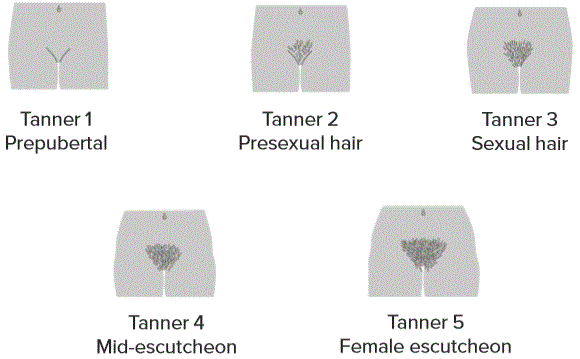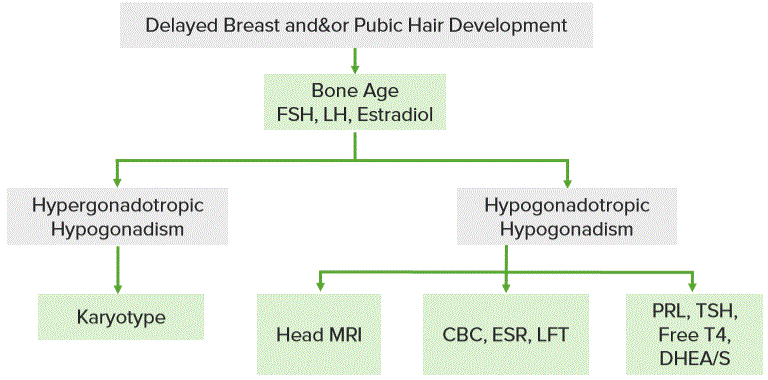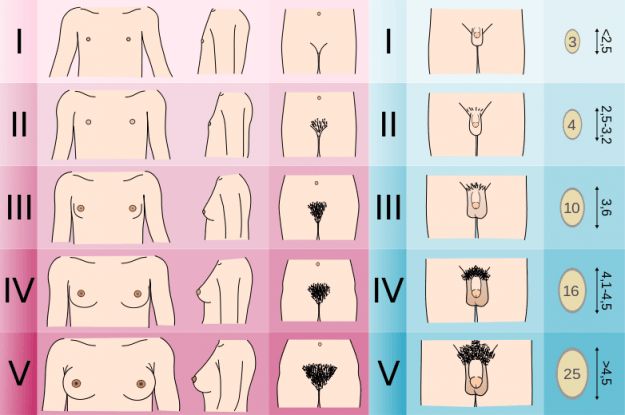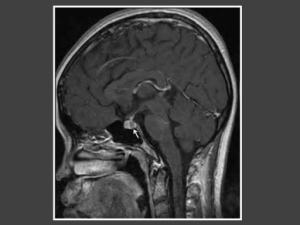Puberty, Precocious Puberty and Delayed Puberty
Image left and right: „Tanner scale – women” und „Tanner-scale – men“ by M•Komorniczak. License: CC BY-SA 3.0
Puberty
Definition of puberty
The word puberty derives from the Latin word “pubertas” and means sexual maturity. It covers the period of time from the first appearance of secondary sexual characteristics until achieving full fertility.
Onset of puberty
Over the years, the median age at the onset of puberty has decreased further and further. The average age of a girl’s menarche is 12.8 years and onset of boy’s voice change is 13.5 years. In general, it is worth stating that the point in time varies from individual to individual and depends on various factors (e.g. nutrition, environment, and climate).
Physical change during puberty
Puberty can be divided into four different consecutive stages: Thelarche, pubarche, growth spurt and menarche.
Thelarche
- Breast development with the formation of breast bud, proliferation of duct and gland epithelium.
- Normally occurring first.
- Participating hormones: estrogen, estradiol, prolactin-Onset: between 7th/8th and 14th year of life.
- Classification: Tanner

“1st Signs of Puberty. Thelarche” Image created by Lecturio
Pubarche
- Growth of pubic and armpit hair.
- Participating hormones: testosterone, 5α-dihydrotestosterone.
- Onset: between 8th/9th and 15th year of life.
- Classification: Tanner

“1st Signs of Puberty. Pubarche” Image created by Lecturio
Growth spurt
- Girls two years earlier than boys, three to ten centimeters of growth per year.
- Participating hormones: sexual steroids lead to the liberation of growth hormones, which leads to the liberation of IGF1 out of the liver.
- About one year after first indicators of puberty.
Menarche
- First menstrual bleeding.
- Bleeding due to oestrogen withdrawal, without preceding ovulation.
- Onset: between 9th and 16th life of the year.
- About one year after a growth spurt.
- Normally occurring last.
Furthermore, a shift in the composition of body tissue takes place. Girls develop more fat tissueand boys develop more muscle tissue.
Sexual hormones have an impact on the skeleton, which makes it possible to link sexual maturity and bone age, which can be recorded by an X-ray of the core of the bone of the wrist, elbow joint or knee.
Stages of development of breast, pubic hair and genitals during puberty
According to Tanner, the development of the female breast, as well as pubic hair growth and development of male genitals can be organized in the following way:
Precocious Puberty
Definition
Precocious puberty means the onset of puberty with the development of external sexual characteristics before turning eight years old. Precocious puberty can create some problems like an early spurt in growth, but, due to early maturation of bones linear growth can be ceased early so it can cause short stature.
Epidemiology
Race may, in part, determine the onset of puberty. For example, in the US, African American girls have an earlier onset of puberty. Some experts suggest redefining precocious puberty as onset before age 6 in African American girls and 7 in all other girls.
Etiology
Factors that are correlated with the earlier onset of puberty in females are low birth weight, obesity, international adoption and absent father. While the age of onset is getting younger, the onset of menarche has not changed significantly. Precocious puberty is important to diagnose and treat because children with untreated precocious puberty tend to be much shorter in adulthood and have a poor psychosocial well-being.
In precocious puberty, if it starts before the age of 6, then there is abnormal brain imaging in 20% of girls. If it starts at the age of 6-8, then abnormal imaging of the brain will only be 2%.
Classification of Precocious Puberty
True precocious puberty has to be distinguished from precocious pseudopuberty. The genesis of the first one is either premature or excessive gonadotropin secretion of the pituitary gland or hypothalamus, which can have idiopathic reasons or can be explained by different reasons, like tumors in CNS, traumas or primary hypothyroidism. In case of precocious pseudopuberty, sex hormones are pathologically increased without a rise in gonadotropin. Reasons for this might be tumors in ovaries or adrenal cortex, as well as iatrogenic influx of oestrogens. Another example for precocious puberty is congenital adrenal hyperplasia.
Clinical Features
The breast development starts prematurely, the onset of growth of pubic and armpit hair starts and menarche comes early. Another sign is rapid growth during early stages with the early lock of the epiphysis and therefore reduced final height.
Diagnosis of Precocious Puberty
First of all, a detailed anamnesis has to be held and patients have to be inspected clinically. This should include sonography in order to evaluate inner sexual characteristics and classification of the external sexual characteristics according to Tanner(see before).
Furthermore, endocrinological diagnostics have to be carried out in order to be able to distinguish central genesis from peripheral genesis. Precocious pseudo-puberty, unlike true precocious puberty, is associated with high levels of sex hormones, while the level of gonadotropin is low. In addition to that, a neurological examination should be carried out, followed by a MR or CT scan to show central genesis.
Treatment of Precocious Puberty
First of all, the underlying genesis of the disease should be treated. By administering GnRH analogs, the endogenous forming of gonadotropins is suppressed due to receptor-down-regulation, which results in less secretion of sex hormones.
Prognosis
If gonadal suppression treatment starts before bone maturation, then normal height can be achieved
Definition of Delayed Puberty
Delayed puberty – belated sexual maturity
The counterpart to precocious puberty is the delayed puberty, in which the onset of puberty is later than usual. This means that there is either no onset of the development of secondary sexual characteristics until the 14th year of life or no menarche until the 16th year of life.
Etiology of Delayed Puberty
Genesis of delayed puberty
The most common reason for delayed puberty is hypogonadotropic hypogonadism with primary ovarian insufficiency. Due to lacking secretion of sex hormones, sexual maturing fails to appear. One possible reason for this might be the Ulrich-Turner syndrome.
Furthermore, hypogonadotropic hypogonadism might be a cause of delayed puberty. In this case, the pituitary gland does not form and release enough GnRH, which leads to a lack of LH and FSH. In case of Kallmann syndrome, in addition to hypogonadotropic hypogonadism, an aplastic or hypoplastic olfactory bulb is present, resulting in anosmia.
An early onset of Anorexia nervosa might be worth considering as a psychological genesis. In rare cases, tumors in pituitary gland or hypothalamus (e.g. hamartoma, dermoid cyst) might be a cause of the disease.
Diagnosis of Delayed Puberty
In this case, anamnesis and clinical examination are expedient. In addition to that, a chromosomal analysis should be carried out in order to determine or exclude Ulrich-Turner syndrome. Furthermore, the determination of the bone age might be an indicator of sexual maturity. Hormone levels need to be defined endocrinologically and radiological inspection of CNS is useful.

: “Delayed Puberty Diagnosis” Image created by Lecturio
Treatment of Delayed Puberty
Therapy of delayed puberty
The first priority is the elimination of possible reasons for the disease. Furthermore, oestrogens and gestagens need to be substituted.
Popular Exam Questions Regarding Malfunctions of Puberty
You can find the correct answers below the references.
1. Which statement about puberty is not true?
- The order of stages of puberty is the following: thelarche – pubarche – growth spurt – menarche.
- Tanner stadium B3 describes an enlargement of breast tissue with glandular tissue that is bigger than the areola.
- Tanner classification includes the development of breast, pubic hair and genitals.
- Normally, girls experience the period of growth spurt about two years later than boys.
- The median age of the onset of puberty is decreasing.
2. The following hormones do not have a direct or indirect influence on puberty or its course:
- Testosterone
- Prolactin
- Oestrogen
- Growth hormones (somatotrophin)
- Insulin
3. Which statement regarding puberty and its malfunctions is true?
- Precocious puberty can be divided into true precocious puberty and false precocious puberty.
- Precocious puberty results in an increased final height of the patients.
- The most common reason for delayed puberty is hypogonadotropic hypogonadism.
- Precocious puberty can be treated by administering GnRH analogues.
- Congenital adrenal hyperplasia is a form of delayed puberty.


Comentários
Enviar um comentário